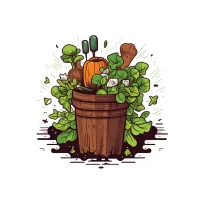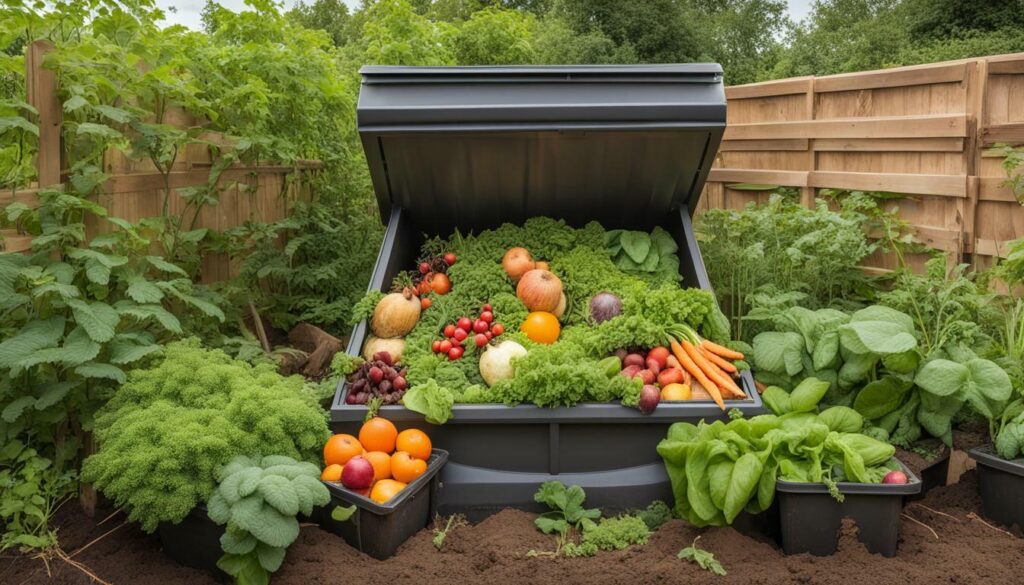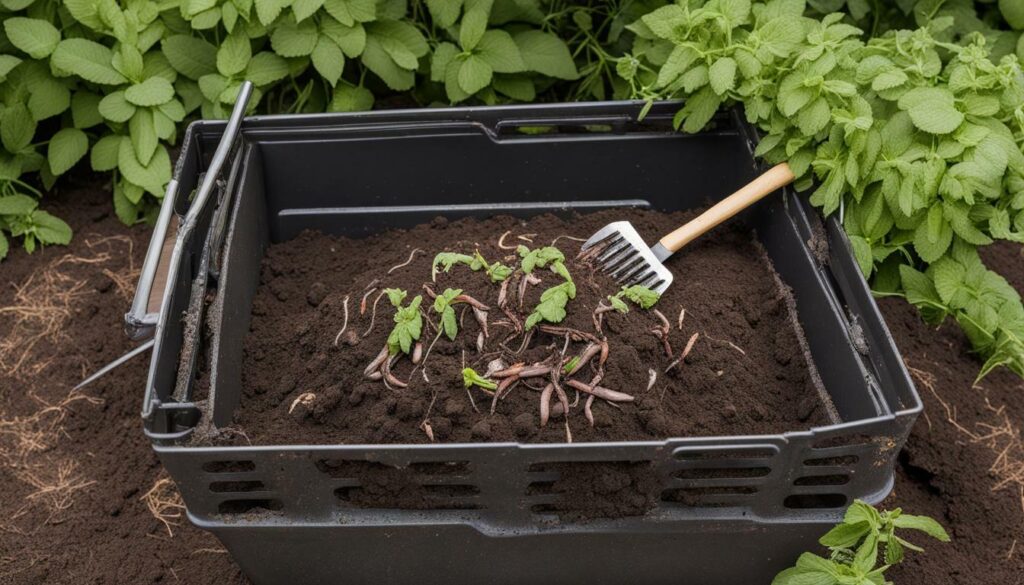Composting food waste is an effective way to reduce the amount of organic waste going to landfills and create a nutrient-rich soil amendment for gardening. However, many people are intimidated by the thought of composting and don’t know where to start.
This beginner’s guide to composting food waste is here to help! Whether you’re a gardening novice or a seasoned pro, these tips and tricks will help you get started with composting in no time.
Key Takeaways:
- Composting food waste helps reduce the amount of organic waste going to landfills.
- Creating a nutrient-rich soil amendment for gardening is just one benefit of composting.
- Whether you’re a beginner or a seasoned pro, these tips and tricks will help you get started with composting.
Why Compost Food Waste?
Food waste is a growing problem globally, with over 1.3 billion tons of food being wasted every year. This waste not only leads to economic losses but also has significant environmental and social impacts. When food waste is sent to landfills, it decomposes anaerobically, leading to the release of methane, a potent greenhouse gas that contributes to climate change. Additionally, the decomposition of food waste in landfills generates leachate, a liquid that can contaminate groundwater and surface water sources.
Composting is a sustainable management solution for organic waste, including food waste. Composting reduces the amount of food waste going to landfills, diverts it from being incinerated, and converts it into a valuable fertilizer that can be used in agriculture, horticulture, and landscaping. Composting also preserves the nutrients in food waste and returns them to the soil, reducing the need for chemical fertilizers.
Reducing food waste through composting not only addresses environmental concerns but also has significant economic benefits. Composting food waste can reduce the cost of waste disposal for households, municipalities, and businesses. Compost can also be used to create revenue through the sale of high-quality fertilizer and other soil amendment products.
Getting Started with Composting Food Waste
Composting food waste may seem daunting, but it’s actually a simple and rewarding process that anyone can do at home. Here’s a step-by-step guide to get you started:
1. Choose a Composting Container
You can compost food waste in a bin or container specifically designed for composting, or you can make your own. Whichever option you choose, make sure it’s big enough to hold all your food scraps and has drainage holes to prevent excess moisture buildup.
2. Collect Your Food Scraps
Collect all your food scraps, including fruits, vegetables, eggshells, coffee grounds, and tea leaves. Avoid adding meat, dairy, and oily foods, as they can attract pests and slow down the composting process.
3. Layer Your Composting Materials
Layer your food scraps with dry materials such as leaves, sawdust, or shredded paper to help aerate the compost and prevent it from becoming too wet. A good rule of thumb is to aim for a mix of roughly 3 parts brown materials to 1 part green materials (food scraps).
4. Keep Your Compost Moist
Your compost needs to stay moist to help break down the materials. If it’s too dry, add some water. If it’s too wet, add more dry materials and mix well.
5. Mix Your Compost Regularly
To speed up the composting process, mix your compost regularly to help aerate it and expose all the materials to the microbes that break them down. You can use a pitchfork or shovel to mix it up.
6. Wait for Your Compost to Mature
Depending on the size of your container and the materials you’re using, it can take anywhere from a few weeks to several months for your compost to mature. Keep adding food scraps and mixing regularly until your compost is dark, crumbly, and smells earthy.
Following these steps will help you create rich, nutrient-dense compost that you can use to fertilize your garden or indoor plants. With a little bit of patience and practice, composting food waste can become a regular part of your sustainable lifestyle.
What Can You Compost?
Composting food waste at home is an effective way to not only reduce the amount of waste that ends up in landfills, but also create a valuable resource for your garden. However, it’s important to know what can and cannot be composted to ensure the process works effectively.
When it comes to food waste, there are many items that can be composted. Fruits and vegetables, coffee grounds, tea leaves, eggshells, nut shells, and even bread can all be added to your compost pile. However, it’s important to avoid adding any meat, dairy products, or oily foods as they can attract pests and slow down the composting process. Additionally, large quantities of citrus fruits should be avoided as they can make the compost too acidic.
If you’re looking to add additional organic material to your compost pile, yard waste such as leaves, grass clippings, and small twigs can also be added. However, it’s important to avoid adding any large branches or woody materials as they take longer to break down and can slow down the composting process.
By following these food waste edition composting tips for beginners, you’ll be on your way to creating rich, nutrient-dense compost for your garden while also reducing your impact on the environment.
Essential Tips for Successful Composting
Composting is a simple process that requires little more than organic materials, air, and water. However, there are some key tips that can help you achieve success with composting food waste, particularly if you’re new to the practice.
1. Balance Your Brown and Green Materials
One of the most important factors to consider when composting food waste is achieving the right balance of brown and green materials. Brown materials are typically carbon-rich and include things like leaves, wood chips, and shredded newspaper. Green materials, on the other hand, are typically nitrogen-rich and include things like food scraps, grass clippings, and coffee grounds. Aim for a ratio of about 3:1 brown to green materials.
2. Avoid Certain Types of Food Waste
While most food waste is suitable for composting, some types should be avoided. Meats and dairy products can attract pests and create unpleasant odors, so it’s best to avoid them. Additionally, citrus fruits can be too acidic and slow down the composting process.
3. Keep Your Compost Moist
Moisture is key to the composting process, as it helps break down organic materials. However, it’s important to strike a balance. Too much moisture can cause the compost to become waterlogged and smelly, while too little can slow down the decomposition process. Aim for a moisture level similar to that of a wrung-out sponge.
4. Turn Your Compost Pile
Turning your compost pile regularly can help ensure that it decomposes evenly and quickly. This can be done with a pitchfork, which allows you to mix the materials and add air. Aim to turn your compost pile at least once a week.
5. Be Patient
Composting is not an overnight process. Depending on the materials used, it can take several months to a year for your compost to fully decompose. Be patient and trust the process.
By following these tips, you can reduce food waste and create nutrient-rich compost for your garden. It’s a win-win for both you and the environment.
Troubleshooting Common Composting Issues
While composting is a simple process, beginners may encounter some common issues along the way. Here are some tips to troubleshoot common composting problems:
Problem: Compost is too wet
If your compost is too wet, add dry materials such as leaves, straw, or shredded paper to the mix. Turning the compost pile regularly can also help aerate and dry it out.
Problem: Compost is too dry
If your compost is too dry, add moisture by watering it or adding wet kitchen scraps. Turning the compost pile regularly can also help mix in moisture.
Problem: Compost smells bad
If your compost smells bad, it may be too wet or have too much nitrogen-rich material such as food scraps. To fix the issue, add more carbon-rich materials such as leaves, straw, or shredded paper. Make sure to turn the compost regularly to aerate and mix the materials.
Problem: Compost is not breaking down
If your compost is not breaking down, it may not have enough moisture or nitrogen-rich material. Make sure to add wet kitchen scraps and regularly water the compost. Turning the compost pile can also help mix in the materials.
By following these composting tips for beginners, you can reduce food waste through composting and successfully create nutrient-rich compost for your garden.
Harvesting and Using Compost
Once your compost has been breaking down for several weeks or months, it will eventually turn into dark, crumbly soil-like material that is rich in nutrients. Harvesting this compost is simple and rewarding. To start, stop adding new materials to your compost bin or pile for about two weeks before you plan to harvest. This will give the microorganisms in the compost enough time to stabilize, which will prevent new materials from being broken down too quickly and ensure that the compost is fully mature.
| Steps for Harvesting Compost: |
|---|
| 1. Scoop out the top layer of compost using a shovel or trowel. |
| 2. Set the top layer of compost aside in a separate container or pile. This will be added back into the compost bin or pile as “brown” material. |
| 3. Use a pitchfork or garden fork to turn the remaining compost over and aerate it. |
| 4. Remove any large, undecomposed materials that you find. |
| 5. Repeat steps 1-4 until you have removed all of the compost and are left with a pile of undecomposed materials and the bottom layer of the compost bin or pile. |
Now that you have harvested your compost, you can use it in a variety of ways. Spread it over your garden or lawn as a natural fertilizer, mix it into potting soil for houseplants or seedlings, or use it to make compost tea, which can be sprayed directly onto plants to provide them with a nutrient boost. As you use your compost, be sure to continue adding new materials to your compost bin or pile to keep the process going and reduce your food waste.
Remember, composting is a simple and effective way to reduce your food waste and improve the health of your garden or houseplants. With a little bit of patience and some basic knowledge, anyone can compost their food scraps at home. Use these composting tips for beginners to get started today!
Advanced Composting Techniques
Once you have established a solid foundation for composting food waste, it’s time to take it up a notch with some advanced techniques. These methods will expedite the composting process, reduce odors, and provide you with even richer compost to nourish your garden.
Hot Composting
Hot composting is a popular technique for breaking down organic material quickly. This method requires a higher level of attention and maintenance than traditional composting, but the payoff is worth it. Hot composting involves mixing together equal parts of green and brown materials like grass clippings and dried leaves, respectively. Make sure to keep your compost pile moist and turn it frequently to aerate it.
With hot composting, the internal temperature of your compost pile can reach up to 160 degrees Fahrenheit. This temperature kills off weed seeds and harmful bacteria, resulting in a nutrient-rich finished compost in just a few months.
Vermicomposting
Vermicomposting is a process that uses composting worms to break down food waste into nutrient-rich castings. This technique is ideal for those who don’t have access to a yard or outdoor space. Vermicomposting can be done indoors in a small bin or container.
Red worms, also known as red wigglers, are commonly used for vermicomposting. They eat food waste and produce castings, which can be used as a potent fertilizer for plants. Make sure to keep your bin well-ventilated, moist, and cool to ensure the worms stay healthy and active.
Bokashi Composting
Bokashi composting is a Japanese technique that uses a mix of microorganisms to ferment food waste. This method is ideal for those who want to compost meat, dairy, and other food waste that typically cannot be composted in traditional systems. Bokashi composting requires a special container and a bokashi mix that contains beneficial microorganisms.
The process involves layering food waste with the bokashi mix and then sealing the container. The microorganisms break down the food waste, creating a nutrient-rich liquid that can be used as a fertilizer. After two weeks, the contents of the container can be added to a traditional compost pile or buried in the soil, where it will continue to decompose and enrich the soil.
By using these advanced composting techniques, you can reduce food waste even further and create rich, healthy soil for your plants. Remember, different techniques work better for different people, so don’t be afraid to experiment and find what works best for you.
Conclusion
In conclusion, composting food waste is an easy and sustainable way to manage food scraps at home. By reducing the amount of food waste sent to landfills, you can help to reduce greenhouse gas emissions and protect the environment.
To get started with composting, follow our beginner’s guide and use our step-by-step instructions to start composting your food waste. Remember to choose the right balance of carbon-rich and nitrogen-rich materials, and turn your compost regularly to promote decomposition.
By following these tips, you can create high-quality compost that can be used to nourish your garden or houseplants. Start composting today and make a positive impact on the environment!



